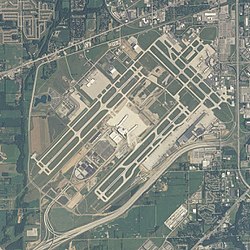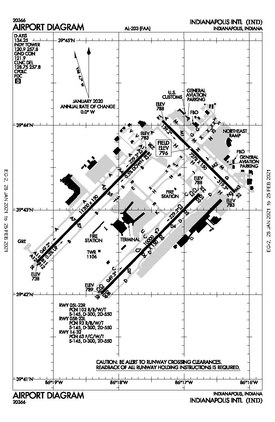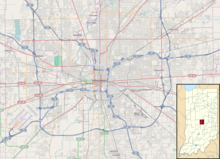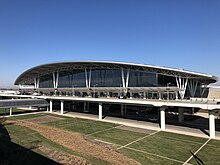avia.wikisort.org - Aerodrome
Indianapolis International Airport (IATA: IND, ICAO: KIND, FAA LID: IND) is an international airport located seven miles (11 km) southwest of downtown Indianapolis in Marion County, Indiana, United States.[2] It is owned and operated by the Indianapolis Airport Authority. The Federal Aviation Administration (FAA) National Plan of Integrated Airport Systems for 2017–2021 categorized it as a medium hub primary commercial service facility.[3]
Indianapolis International Airport | |||||||||||||||||||
|---|---|---|---|---|---|---|---|---|---|---|---|---|---|---|---|---|---|---|---|
 | |||||||||||||||||||
| |||||||||||||||||||
| Summary | |||||||||||||||||||
| Airport type | Public | ||||||||||||||||||
| Owner/Operator | Indianapolis Airport Authority | ||||||||||||||||||
| Serves | Indianapolis | ||||||||||||||||||
| Location | 7800 Col. H. Weir Cook Memorial Drive Indianapolis, Indiana, United States | ||||||||||||||||||
| Opened | 1931 | ||||||||||||||||||
| Hub for | FedEx Express | ||||||||||||||||||
| Focus city for | Allegiant Air | ||||||||||||||||||
| Elevation AMSL | 797 ft / 243 m | ||||||||||||||||||
| Coordinates | 39°43′02″N 086°17′40″W | ||||||||||||||||||
| Public transit access | |||||||||||||||||||
| Website | ind.com | ||||||||||||||||||
| Maps | |||||||||||||||||||
 FAA airport diagram as of January 2021 | |||||||||||||||||||
 IND Location within Indianapolis  IND IND (Indiana)  IND IND (the United States) | |||||||||||||||||||
| Runways | |||||||||||||||||||
| |||||||||||||||||||
| Statistics (2021) | |||||||||||||||||||
| |||||||||||||||||||
Source: Indianapolis International Airport[1] | |||||||||||||||||||
The airport occupies 7,700 acres (3,116 ha) in Wayne and Decatur townships in Marion County and Guilford Township in Hendricks County.[2][4] IND is home to the second largest FedEx Express hub in the world; only the FedEx SuperHub in Memphis, Tennessee surpasses its cargo traffic. Additionally, because of FedEx's activity, IND ranked as the sixth busiest U.S. airport in terms of air cargo throughput in 2020.[5][6]
History
Beginnings
This section needs expansion. You can help by adding to it. (July 2022) |
Indianapolis Municipal Airport opened in 1931. In 1944, it was renamed Weir Cook Municipal Airport, after US Army Air Forces Col. Harvey Weir Cook of Wilkinson, Indiana, who became a flying ace during World War I with seven victories and died flying a P-39 over New Caledonia in World War II.
Since 1962, the airport has been owned and operated by the Indianapolis Airport Authority (IAA), an eight-member board with members appointed by the Mayor of Indianapolis and other officials from Marion, Hendricks and Hamilton counties in central Indiana. In 1976, the board renamed the airport Indianapolis International Airport.[7]
From 1957 to 2008, the passenger terminal was on the east side of the airfield off High School Road. This now-demolished facility was renovated and expanded many times, notably in 1968 (Concourses A & B), 1972 (Concourse D) and 1987 (Concourse C and the attached Parking Garage). This complex, along with the International Arrivals Terminal (opened in 1976) on the north side of the airfield (off Pierson Drive), was replaced by the Col. H. Weir Cook Terminal on November 12, 2008. [citation needed]
The April 1957 OAG shows 82 weekday departures: 24 Eastern, 22 TWA, 15 Delta, 11 American, 9 Lake Central and 1 Ozark. Eastern had a nonstop to Atlanta and one to Birmingham and TWA had two to LaGuardia; no other nonstops reached beyond Chicago, St. Louis, Memphis, Louisville and Pittsburgh. (Westward nonstops didn't reach beyond St. Louis until 1967; TWA started a JFK-IND-LAX 707 that year.) The first jets were TWA 880s in 1961. [citation needed]
Recent years
During the late 1980s and early 1990s, USAir (later US Airways) had a secondary hub in Indianapolis with non-stop jets to the West Coast, East Coast and Florida and turboprop flights to cities around the Midwest. USAir peaked at 146 daily departures (including its prop affiliates), with 49% of all seats. USAir ended the hub in the late 1990s. [citation needed]
In the late 1990s and early 2000s, Indianapolis was a hub for then locally based ATA Airlines and its regional affiliate, Chicago Express/ATA Connection. After that airline entered Chapter 11 bankruptcy protection in late 2004, operations at IND were cut, then eliminated in 2006.[8] ATA's demise gave Northwest Airlines an opportunity to expand operations, making Indianapolis a focus city with mainline flights to the West Coast, East Coast, and the South. Northwest was later acquired by Delta Air Lines in 2008, and a decade later, Delta began service from Indianapolis to Paris beginning in May 2018. This flight was the first ever non-stop transatlantic passenger flight out of Indianapolis.[9] The flight, DL500, was suspended in March 2020.[10]
In 1994, BAA USA was awarded a 10-year contract to manage the Indianapolis International Airport. The contract was extended three years but was later cut a year short at the request of the BAA. Private management ended on December 31, 2007, and control reverted to IAA.[11][12] Also in 1994, United Airlines finished building the Indianapolis Maintenance Center,[13] at a cost of US$600 million.[14] United later moved their maintenance operations to its sole maintenance hub located at San Francisco International Airport. Around 2006, runway 14/32 was shortened from 7,604 feet (2,318 m) to its present length because the south end was not visible from the new control tower.[15]

A new 1.2-million-square-foot (110,000 m2) midfield passenger terminal, which cost $1.1 billion, opened in 2008 between the airport's two parallel runways, southwest of the previous terminal and the crosswind runway. A new FAA Air Traffic Control Tower (ATCT) and Terminal Radar Approach Control (TRACON) building, the second tallest in the United States, opened in April 2006, the first component of the long-planned midfield complex. The Weir Cook Terminal itself opened for arriving flights on the evening of November 11, 2008, and for departures the following morning. HOK was its master designer, with AeroDesign Group (a joint venture among CSO Architects, SchenkelShultz Architecture and ARCHonsortium) serving as the architect of record. Aviation Capital Management (Indianapolis), a subsidiary of BSA LifeStructures, was the airport's program manager. Hunt/Smoot Midfield Builders, a joint venture of Hunt Construction Group and Smoot Construction was the construction manager.[16] Thornton Tomasetti was the terminal's structural engineer along with Fink, Roberts and Petrie.[17] Syska Hennessy was the mechanical, electrical, & plumbing engineer.[17] In 2021, a six-person panel of American Institute of Architects (AIA) Indianapolis members identified the Col. H. Weir Cook Terminal among the ten most "architecturally significant" buildings completed in the city since World War II.[18]
In August 2017, Allegiant Air announced it would open a $40 million aircraft base at Indianapolis International Airport that would begin operations in February of the following year. The facility was to create 66 high-paying jobs by the end of year and house two Airbus aircraft.[19][20]
Facilities
Terminal

Indianapolis International Airport has a single terminal with two concourses and a total of 39 gates.[21] The current terminal opened in 2008 and is named in honor of Col. Harvey Weir Cook. It was one of the first designed and built in the U.S. following the September 11 attacks.[22] All international arrivals are processed in Concourse A.[21]
Ground transportation
Eight rental car operations and the Ground Transportation Center (where information about limousine, shuttle bus, hotel courtesy vehicles and other transportation services such as IndyGo bus service can be obtained) are located on the first floor of the attached parking garage. All pick-ups and drop-offs of rental vehicles also occur here, eliminating the need for shuttling customers to and from individual companies' remote processing facilities. The five-floor parking garage covers 11 acres (4.5 ha) on each of its levels. It features a light-filled center atrium complete with a piece of suspended artwork and contains moving sidewalks to speed pedestrians into and out of the terminal building itself.[23]
Airlines and destinations
Passenger
Cargo
Statistics



Top destinations
| Rank | City | Passengers | Carriers |
|---|---|---|---|
| 1 | Atlanta, Georgia | 438,000 | Delta, Southwest |
| 2 | Denver, Colorado | 269,000 | Frontier, Southwest, United |
| 3 | Orlando, Florida | 253,000 | Frontier, Southwest, Spirit |
| 4 | Dallas/Ft. Worth, Texas | 209,000 | American |
| 5 | Las Vegas, Nevada | 203,000 | Allegiant, Frontier, Southwest, Spirit |
| 6 | Chicago–O'Hare, Illinois | 201,000 | American, United |
| 7 | Phoenix–Sky Harbor, Arizona | 189,000 | American, Southwest |
| 8 | Charlotte, North Carolina | 181,000 | American |
| 9 | Minneapolis–Saint Paul, Minneapolis | 135,000 | Delta, Sun Country |
| 10 | Fort Myers, Florida | 130,000 | Southwest, Spirit |
| Rank | City | Cargo (pounds) | Carriers |
|---|---|---|---|
| 1 | Los Angeles, California | 6,944,183 | Cargolux, FedEx Express |
| 2 | Oakland, California | 6,717,406 | FedEx Express |
| 3 | Memphis, Tennessee | 6,603,929 | FedEx Express |
| 4 | Newark, New Jersey | 5,786,845 | FedEx Express |
| 5 | Boston, Massachusetts | 4,590,933 | FedEx Express |
| 6 | Dallas/Fort Worth, Texas | 3,996,817 | FedEx Express |
| 7 | Seattle/Tacoma, Washington | 3,943,765 | FedEx Express |
| 8 | Denver, Colorado | 3,718,289 | FedEx Express |
| 9 | Anchorage, Alaska | 3,592,389 | FedEx Express |
| 10 | Atlanta, Georgia | 3,588,692 | FedEx Express |
Airline market share
| Rank | Airline | Passengers | Share |
|---|---|---|---|
| 1 | Southwest Airlines | 2,135,000 | 27.70% |
| 2 | Republic Airways | 1,102,000 | 14.30% |
| 3 | Delta Air Lines | 974,000 | 12.64% |
| 4 | American Airlines | 939,000 | 12.19% |
| 5 | Spirit Airlines | 570,000 | 7.39% |
| 6 | Other | 1,987,000 | 25.78% |
Annual traffic
| Year | Passengers | Year | Passengers | Year | Passengers |
|---|---|---|---|---|---|
| 1996 | 7,069,039 | 2006 | 8,085,394 | 2016 | 8,511,959 |
| 1997 | 7,171,845 | 2007 | 8,272,289 | 2017 | 8,800,828 |
| 1998 | 7,292,132 | 2008 | 8,151,488 | 2018 | 9,413,962 |
| 1999 | 7,463,536 | 2009 | 7,465,719 | 2019 | 9,537,377 |
| 2000 | 7,722,191 | 2010 | 7,526,414 | 2020 | 4,104,648[43] |
| 2001 | 7,238,744 | 2011 | 7,478,835 | 2021 | 7,175,979[44] |
| 2002 | 6,896,418 | 2012 | 7,333,733 | 2022 | |
| 2003 | 7,361,060 | 2013 | 7,217,051 | 2023 | |
| 2004 | 8,025,051 | 2014 | 7,363,632 | 2024 | |
| 2005 | 8,524,442 | 2015 | 7,998,086 | 2025 |
Passenger traffic trends
Accidents and incidents
- On September 9, 1969, Allegheny Airlines Flight 853 on a Boston – Baltimore – Cincinnati – Indianapolis – St. Louis route, collided in midair with a Piper Cherokee during its descent over Fairland, Indiana, in Shelby County. The McDonnell Douglas DC-9-31 crashed into a cornfield near London, Indiana, killing all 78 passengers and 4 crew members on board. The student pilot who was flying the Cherokee was also killed.
- On October 20, 1987, a United States Air Force A-7D Corsair II crashed into a Ramada Inn near the airport after the pilot was forced to eject due to an engine malfunction. Ten people were killed, nine of them hotel employees.[45]
References
- "Airline Activity Report December 2019" (PDF). d1j6zi7czwjuok.cloudfront.net. Indianapolis Airport Authority. Retrieved November 16, 2020.
- FAA Airport Form 5010 for IND PDF
- "List of NPIAS Airports" (PDF). FAA.gov. Federal Aviation Administration. October 21, 2016. Archived (PDF) from the original on May 3, 2017. Retrieved August 18, 2018.
- "IND airport at skyvector.com". skyvector.com. Retrieved August 19, 2022.
- "IND Transport Stats". About IND. Archived (PDF) from the original on September 4, 2014. Retrieved October 7, 2020.
- "CY 2015 All-Cargo Landed Weights, Rank Order" (PDF). Federal Aviation Administration. 2016. Archived (PDF) from the original on May 1, 2017. Retrieved July 22, 2018.
- "Airport keeps name, but will honor Weir Cook". 6 News Indianapolis. July 18, 2008. Archived from the original on August 26, 2012. Retrieved July 18, 2008.
- "ATA Expects to Stop Flights From Its Hometown in January". New York Times. November 2, 2005. Retrieved December 27, 2013.
- "Delta announces non-stop flights from Indianapolis to Paris". September 6, 2017. Archived from the original on September 12, 2017. Retrieved September 7, 2017.
- "Delta's Indianapolis to Paris flight won't resume for some time". April 29, 2020. Retrieved January 5, 2021.
- "Indianapolis International Airport: Error". Archived from the original on May 11, 2015. Retrieved June 4, 2015.
- "Home" (PDF). Archived (PDF) from the original on September 24, 2015. Retrieved June 4, 2015.
- "Facility Facts & Statistics: Indianapolis Maintenance Center" (PDF). Indianapolis Airport Authority. Archived from the original (PDF) on July 12, 2012. Retrieved December 27, 2013.
- Bybee, Roger. "Con Air: The 'Safe' Offshoring of Airline Repair – Working In These Times". Inthesetimes.com. Archived from the original on October 11, 2014. Retrieved December 27, 2013.
- O'Malley, Chris (January 4, 2006). "New Indianapolis Airport Control Tower Has a Blind Spot". Aviation Pros. Archived from the original on December 6, 2017. Retrieved April 15, 2021.
- "New Terminal at Indianapolis International Airport Now Boarding". Hunt Construction Group. Archived from the original on January 23, 2009. Retrieved January 4, 2009.
- Wood, Debra (March 1, 2008). "Hoosier Upgrade". Construction Magazine. Archived from the original on March 27, 2013. Retrieved January 23, 2013.
- Shuey, Mickey (December 3, 2021). "Indy's Top 10 architecturally wondrous buildings". Indianapolis Business Journal. IBJ Media. Retrieved September 6, 2022.
- "NEWS: Allegiant Plans Aircraft Base in Indiana, New Jobs and Future Growth". mailchi.mp.
- "Instagram post by Allegiant • Aug 2, 2017 at 9:37pm UTC". Instagram. Archived from the original on December 23, 2021.
- "IND Terminal Map". Retrieved July 7, 2022.
- "The New Indianapolis International Airport Fact Sheet" (PDF). Indianapolis Airport Authority. August 25, 2008. Archived (PDF) from the original on August 19, 2018. Retrieved August 18, 2018.
- "Indianapolis International Airport – Community Days brochure, October 11–12, 2008" (PDF). August 4, 2008. Archived from the original (PDF) on June 11, 2011.
- "Flight Schedules". Archived from the original on September 25, 2019. Retrieved January 7, 2017.
- Airlines, Alaska. "Flight Timetable". Alaska Airlines. Archived from the original on February 2, 2017. Retrieved January 29, 2017.
- "Allegiant Air". Archived from the original on July 17, 2017. Retrieved August 22, 2018.
- "Flight schedules and notifications". Archived from the original on February 2, 2017. Retrieved January 7, 2017.
- "Contour Airlines Route Map". Retrieved October 25, 2021.
- "FLIGHT SCHEDULES". Archived from the original on June 21, 2015. Retrieved January 7, 2017.
- Salerno, Michael. "Frontier Airlines just added a slew of new flights from Phoenix. Here's where you can go". AZCentral. Retrieved August 26, 2022.
- "Frontier Airlines Announces 27 Nonstop Routes, 2 New International Destinations".
- "Frontier". Archived from the original on September 12, 2017. Retrieved January 7, 2017.
- "Southwest Airlines - Check Flight Schedules".
- "Check Flight Schedules". Archived from the original on February 2, 2017. Retrieved January 7, 2017.
- "Where we fly, flight schedules, flight map". Archived from the original on December 23, 2017. Retrieved December 11, 2018.
- Thomas, Dylan (January 25, 2021). "Sun Country announces 16 new routes, including nine serving MSP". Minneapolis / St. Paul Business Journal. Retrieved May 10, 2022.
- "Timetable". Archived from the original on January 28, 2017. Retrieved January 7, 2017.
- "RITA | BTS | Transtats". Transtats.bts.gov. Retrieved October 23, 2022.
- "Indianapolis, IN: Indianapolis International (IND)". Bureau of Transportation Statistics. March 2018. Archived from the original on August 23, 2018. Retrieved June 2, 2020.
- "BTS". Retrieved June 26, 2022.
{{cite web}}: CS1 maint: url-status (link) - "Archived copy" (PDF). Archived from the original (PDF) on April 4, 2015. Retrieved April 2, 2015.
{{cite web}}: CS1 maint: archived copy as title (link) - for 1996 to 2005 - "Airline Activity Reports". Indianapolis International Airport. Archived from the original on December 1, 2017. Retrieved November 20, 2017. - individual reports for 2005 and following years
- Indianapolis Airport. "Indianapolis December 2020 Airline Activity Report" (PDF). Retrieved February 18, 2021.
{{cite web}}: CS1 maint: url-status (link) - Indianapolis International Airport. "Dec 2021 Airline Activity Report" (PDF). Indianapolis International Airport.
- "Indiana Plane Crashes". Indianapolis Star. April 1, 2002. Archived from the original on June 27, 2013. Retrieved June 6, 2008.
External links
- Indianapolis International Airport (official site)
- FAA Airport Diagram (PDF), effective November 3, 2022
- Resources for this airport:
- AirNav airport information for KIND
- ASN accident history for IND
- FlightAware airport information and live flight tracker
- NOAA/NWS weather observations: current, past three days
- SkyVector aeronautical chart for KIND
- FAA current IND delay information
На других языках
[de] Indianapolis International Airport
Der Indianapolis International Airport ist der internationale Flughafen der Stadt Indianapolis im US-Bundesstaat Indiana.- [en] Indianapolis International Airport
[es] Aeropuerto Internacional de Indianápolis
El Aeropuerto Internacional de Indianápolis (en inglés: Indianapolis International Airport) (IATA: IND, OACI: KIND, FAA LID: IND) es un aeropuerto internacional ubicado a 11 km (7 millas) al suroeste del centro de Indianápolis en el condado de Marion, Indiana, Estados Unidos.[2] Es propiedad y está operado por la Autoridad del Aeropuerto de Indianápolis. El Plan Nacional de Sistemas Aeroportuarios Integrados de la Administración Federal de Aviación (FAA) para 2017-2021 lo clasificó como una instalación de servicio comercial primario de centro medio.[3][fr] Aéroport international d'Indianapolis
L'aéroport international d'Indianapolis (en anglais Indianapolis International Airport) (code IATA : IND • code OACI : KIND • code FAA : IND) est un aéroport public situé au sud-est du central business district d'Indianapolis, situé dans le comté de Marion dans l'Indiana aux États-Unis. L'aéroport est géré par l'autorité aéroportuaire d'Indianapolis. Il s'agit du plus grand aéroport de l'Indiana, occupant 3 116 ha. Les autoroutes I-65, I-69, I-70, et I-74 se situent à côté de l'aéroport qui le connectent à la ville par la rocade I-465.[it] Aeroporto Internazionale di Indianapolis
L'aeroporto internazionale di Indianapolis è un aeroporto situato a 11 km a sud ovest dal centro di Indianapolis, negli Stati Uniti d'America.Другой контент может иметь иную лицензию. Перед использованием материалов сайта WikiSort.org внимательно изучите правила лицензирования конкретных элементов наполнения сайта.
WikiSort.org - проект по пересортировке и дополнению контента Википедии